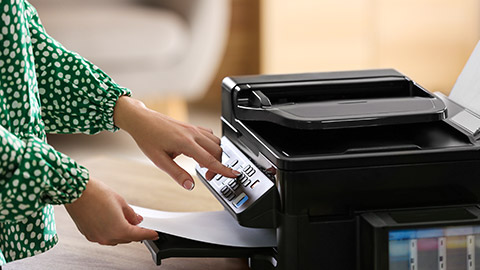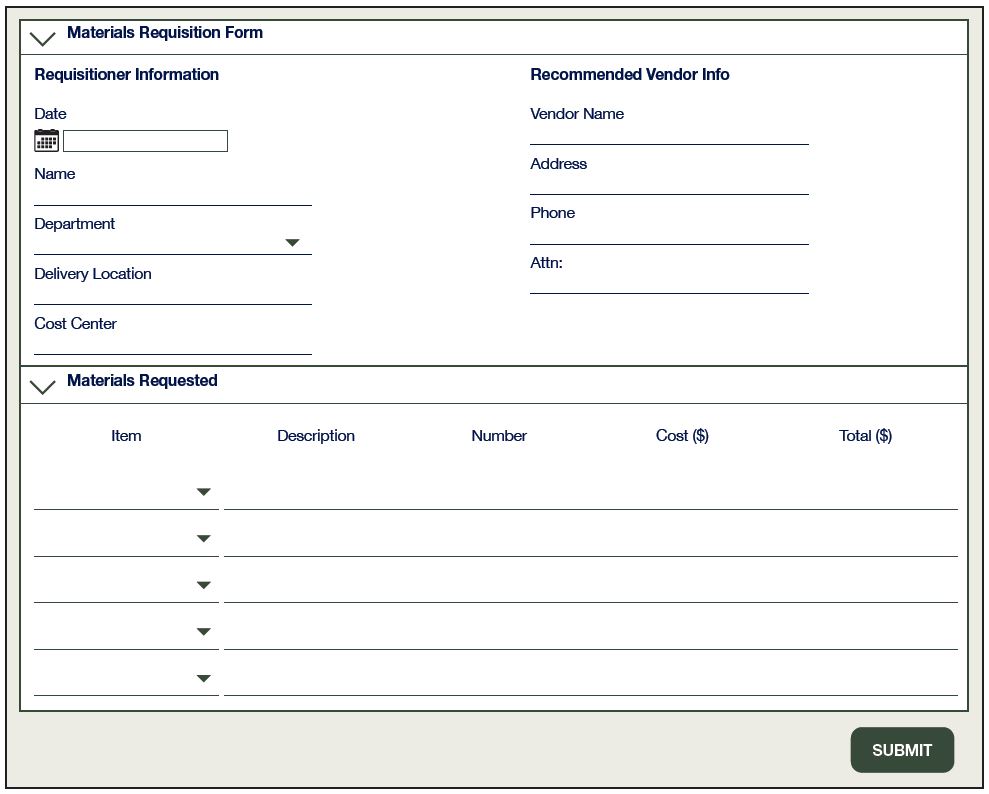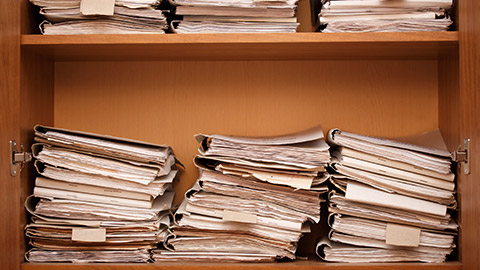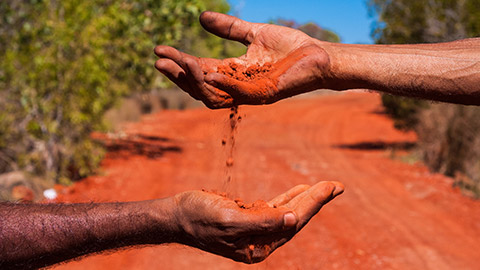Printing on both sides of the paper is an example of responsible sustainability practices.
The term work practices refers to the specific duties and tasks that relate to your job description and that you find yourself carrying out on a regular basis during your employment.
Fostering Sustainable Work Practices
Let's start this section by refreshing our knowledge of the 3 Ps:
Working in a sustainable environment for the planet, the people, and profit has multiple benefits. The focus is your organisation's long-term health, wellbeing, motivation, and productivity levels.
The internet is filled with websites and articles dedicated to this topic, which can be searched using keywords such as:
- reducing workplace stress
- fostering a happy work environment
- creating balance in the workplace.
Reflection
Thinking about past jobs that you have held –
- What work practices support sustainability at work?
- How were those communicated to you?
- Did you understand why these policies and procedures were in place?
It's a balance
One of the benefits of working in an environmentally responsible way is the comforting knowledge that you are doing something towards helping with the challenges we all face. And wellbeing is crucial to job satisfaction so these ideas are well connected. However, the three Ps imply a balance.
Annie Leonard, an American proponent of sustainabilityThere is no such things as 'away'. When we throw anything away it must go somewhere.
Reflection
It's important that your balance reflects your joys and comforts. Don't find yourself doing too much of what you don't like just to support what you love. Play to your strengths.
As you work through this course, think about the following questions and considerations. You'll learn there are many ways to help, and some tasks are more suited to some people and industries. Look at these now, see what pops out, and then lean into those notions throughout this learning. Click links that further your efforts in those areas.
Planet
- How relevant is our physical world and its resources to your industry?
- Are there appropriate ways for you to align your new behaviours in your workplace to your industry?
- Does the idea of helping the planet in a direct and physical way resonate with you?
People
- Do you work with a small group, a large group, or primarily on your own?
- Do you feel inspired to set up a sustainability workgroup at the office, or virtual office?
- Working from home? You can also make workplace changes to your home office and work relationships.
- Does communication come comfortably for you?
Profit
Becoming more sustainable in your workplace is a form of self-care. The organisation's profit, therefore, is one of the areas you'll need to balance because it is, in part, your responsibility.
Let's use Dean as an example:
Dean has a lot to do when he is not on-register during his shift at Coles. He needs to replenish stock levels on shelves if low, maintain store cleanliness and aid customers where needed.
He feels that taking regular 5–10 minute breaks every 30–40 minutes is very good for his mental health, leaving him feeling alert and able to give his job the positivity it deserves.
- While it's great that Dean is looking after himself, how do Dean’s attempts at personal sustainability fail to encompass the bigger picture (i.e. planet, people, and profit)?
Your balance
- What is your balance? If you are inspired, take some notes about your thoughts at this point in your journey.
When you read the word waste you probably think of rubbish, which is one type of waste. However, when it comes to the workplace, you also need to be aware of other types of waste.
Case Study: Matilda

Matilda works in a busy HR office where there are many things to be printed, posted to employees, and delivered to colleagues in a large building. When Matilda first started working for the company, she spent lots of time collecting printed materials and handing them to the individuals. To avoid wasting time in her day, Matilda would gather printing each hour, deliver mail to colleagues each morning and post the letters all at the end of the day before she finished. This saved Matilda a lot of time she could spend completing other tasks that needed to be done.
Think: How did Matilda's behaviours support the organisation's commitment to the 3 Ps? Now that Matilda is familiar with her role, do you think there is anything else she can do to support sustainable work practices? (Hint: it involves conversation since she's not in a position to directly impact policy.)
The following table outlines some things your company would do well to consider. Before marching into the CEO's office demanding change, though, consider their scorecard on the following efforts.
| Type of Waste | Example | Responsible practice |
|---|---|---|
| Transportation | Moving materials and staff from one place to another | Avoid unnecessary steps where possible; public transportation; shared rides |
| Inventory | Every product or material that is stored in a business costs money until it is sold | Only store what is needed |
| Motion | Movements of machines and people that are not necessary |
Streamline — make movements in between processes easier. |
| Waiting | Downtime — when two separate processes do not flow on from one another | Connect processes well so no time is wasted. |
| Overprocessing | Put more into the product than the customer values |
Meet customer needs and do not do more. Look into Design Thinking to learn how to find out about customer needs. |
| Overproduction | Producing more volume of product or producing it faster than needed | Only produce what is needed and not more |
| Defects | Errors or mistakes in a product that will take time to fix |
Put in QA processes to help avoid mistakes. |
Jerry Greenfield, Co-founder of Ben & Jerry’s Ice CreamRecycling, packaging, businesses are changing all of those things because that’s what consumers want.

Readings
- The 7 Wastes of Lean Production by Leah Gourley
- Energy Saving Tips for Businesses by SRP
- Ways to Save Water in the Office by Miriam Wolf
- 10 Ways to Reduce Waste in the Workplace by ISCG
- Reduce energy use in your business by Sustainability Victoria

Workplace Resources
Most employees in a business environment will use a wide range of resources. The following table outlines how resources are categorised and the typical resources you would find in a workplace.
| Resource | Example |
|---|---|
| Natural | Water, gas, paper, coal or solar energy, chemicals, oil, petrol |
| Technical | Knowledge of the business and its employees, access to the internal and software applications |
| Digital | Social media marketing accounts, online analytics, customer and supplier information |
| General | Business policies and procedures, salaries and wages |
Understanding not only what resources we are using but also how much we are using can help us identify imbalances impacting sustainability, be it to ourselves, the planet, or the organisation’s profit.
Explore
This nearly 4-minute video from LACOE provides guidelines for sustainable workplace practices.Monitoring Resources
In many organisations, employees are required to account for the resources they use. Often this is quite a formal procedure, particularly with many technical and digital resources.
For example, a staff member may be required to sign in when using specific machinery due to the potential for risk or injury to untrained persons or to monitor how much material is being used to perform the same task by different staff members, i.e., a numerical key that identifies the printer usage of each user individually.
In the case of digital resources, your organisation may provide you with an expensive laptop computer to complete your digital tasks.
Natural Resources

Turning off lights when a room will sit empty is good business practice. As the spotlight expands on the issue of climate change, more and more organisations are looking at their environmental impact and how they can contribute to a more naturally sustainable workplace.
Natural resources include energy, gas and water.
Read: Read the following article by Annelie Xenofontos from Axiom, which describes several tips for office sustainability: 5 Ways to Make Your Office More Sustainable.
Reflection
Using your journal, list three ways you can reduce energy usage in the workplace.Actions you may be able to take right now
The following list shows some of the things that you might be able to do — and influence others to do — to reduce the use of resources at your workplace.
- Save paper by printing on both sides.
- Reduce electricity usage by turning machines off overnight at the power point.
- Use energy-efficient lighting and natural light where possible to save electricity.
- Save fuel for transport by adjusting travel requirements.
- Encourage staff to use washable cups rather than disposable ones.
Documenting Resource Usage
Using spreadsheets, requisition forms, and other methods to track ordering can be simple and effective steps to monitor resource usage and expenditure. Many organisations use templates to collate data and statistics relating to resource usage.
Whether paper-based or digital, once stored appropriately, these documents can be used to track usage and potential overuse, wastage, etc.
Though filing documents is often a tedious and dull task, following the correct procedures, in this case, will allow organisations to become more sustainable in terms of their resource usage.
Sample requisition form

Source: Integrify
Reflection
Scenario
At ABC Company, the accounts department is required to complete a monthly requisition for stationary supplies for the following month. The information is recorded and stored on paper, in a binder near the printer.
- In January, they requested 15 reams of print/copy paper
- In February, they requested 14 reams of print/copy paper
- In March, they requested 24 reams of print/copy paper
- In April, they requested 16 reams of print/copy paper.
Consider the question below, and then select the label or (+) sign to see the answer.
The method of collecting resource usage data will depend on several factors including the organisation’s reliance upon it, the resource type and how much information is needed.
If you are collecting data regularly, recording that data in a spreadsheet rather than a paper-based table will probably be more useful because it will enable calculations and graphs to be made using the information entered.
Importance of Correct Storage

Earlier in this chapter, we talked about the importance of filing resource documentation for sustainability improvement purposes. We should also note that most organisations have compliance policies regarding filing. Companies often need to locate and retrieve documentation time-efficiently for various purposes including business, legal, WHS, etc.
Historically, as most documentation existed in paper format, filing cabinets, filing boxes, and similar systems were used to store and keep track of important documentation. Most organisations are now storing information electronically to save paper and for efficiency and space-saving reasons. This method allows easier storage, location, and retrieval of documents.
Access to documents stored electronically can also be controlled and protected, making managing multiple versions easier.

In any workplace, there will be different views about sustainability, its relevance and it's importance in the business world. It is important that everyone understand the broad benefits of engaging in environmentally responsible practices, both in a business and environmental sense.
Variations in views may be due to experience, interest, education, generational influence and culture. For example, Aboriginal and Torres Strait Islander people have a slightly different take on sustainability given their intrinsic and spiritual connection to the earth, land, water, air, community, flora, fauna and ecosystems:
We believe that Country is not only the Land and People, but is also the Entities of Waterways, Animals, Plants, Climate, Skies and Spirits. Within this, one Entity should not be raised above another, as these live in close relationship with one another. So People are no more or less important than the other Entities
Martin & Mirraboopa, 2003, p. 207
Aboriginal and Torres Strait Islander people use practices to read the environment and provide what the earth needs for survival. They have always used naturally sustainable practices in their everyday management of the land and understand the interconnectedness and interdependence of all life forms.
Examples include:
- placing specific plants in a location where they sustain environments
- using fire to control ecosystems
- knowing when to fish, hunt, plant, and harvest.
Aboriginal and Torres Strait Islander people consider the regeneration and cycles and patterns as nature's law, and interrupting this as we are currently doing in various industry sectors, is seen as an act against the laws of nature.
They are always considering a sustainable concept known as the survival of seven generations.
Explore
Watch: this 2-minute video by Academic Algonquin to learn about the concept: ‘Seven Generations’ and then answer the questions below to help consolidate your learning.
| Mother Earth as a Life-Giving Force | In many First Nations languages, Mother Earth is depicted as a living person. If the inhabitants of this world continue to desecrate her, then she will no longer be a life-giving force. |
| Laws of Nature | There was a time and season for all life-sustaining activities. Animals were not killed during their reproductive cycles. |
| Life-Sustaining Elements of the World |
|
| Interrelationships and Interconnectedness | Take no person, animal, or thing for granted. Everyone and everything has a role and a place. |